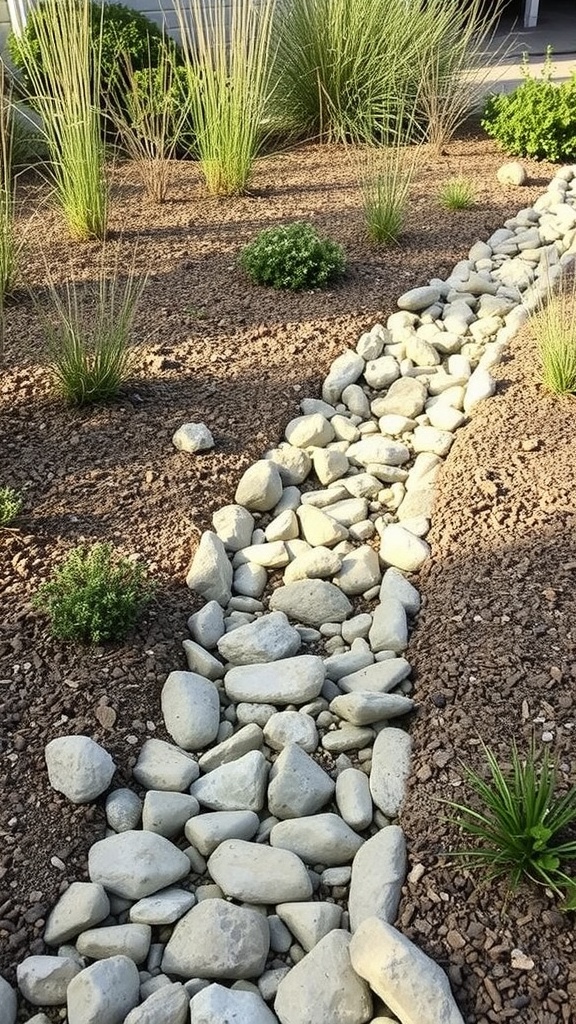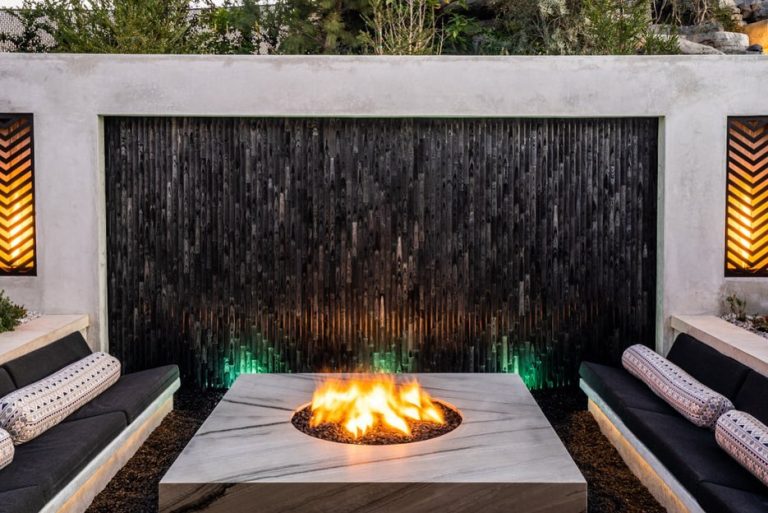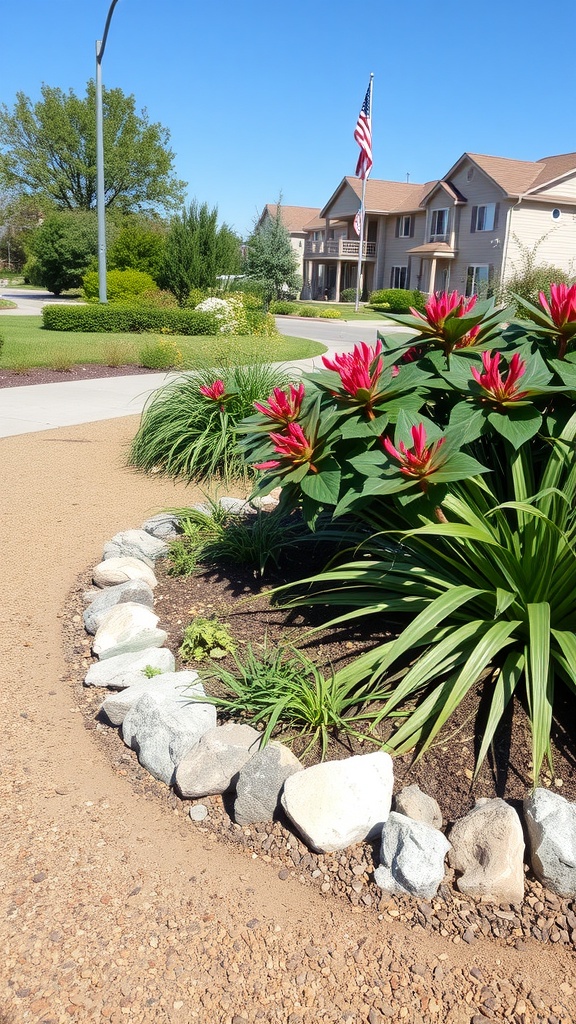21 Creative Yard Drainage Ideas for a Dry Landscape
Finding the right drainage solution for your yard can make all the difference in keeping your landscape healthy and beautiful. Here are 21 creative ideas to tackle drainage issues, from simple fixes to more elaborate systems. Whether you’re dealing with pooling water or soggy spots, there’s something here to help you get your yard in top shape.
Downspout Extensions to Redirect Water
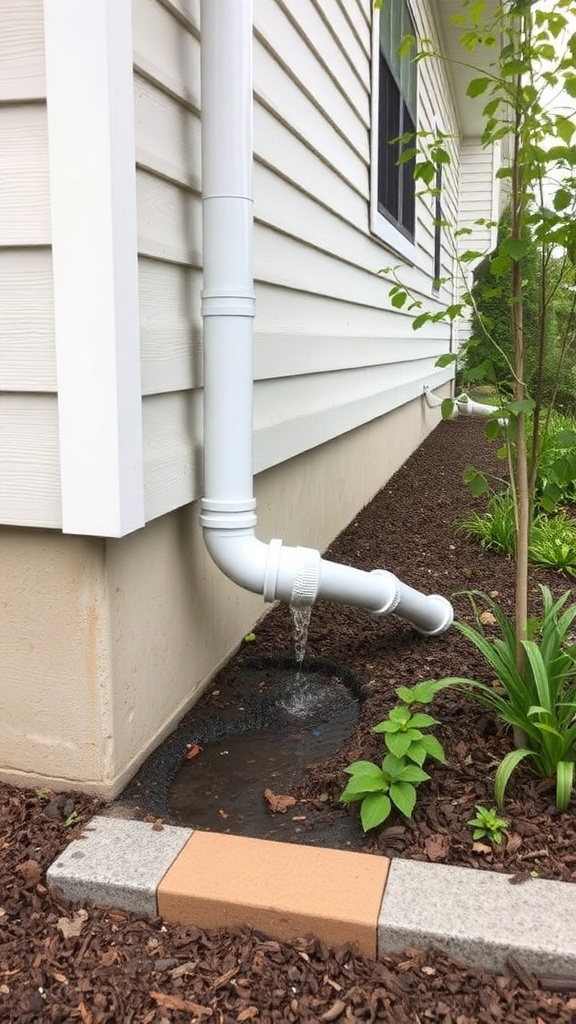
Downspout extensions are a simple yet effective way to manage water flow in your yard. They help redirect rainwater away from your home’s foundation, preventing potential water damage. In the image, you can see a white downspout extending from the side of a house, directing water to a designated area.
This setup not only protects your home but also helps keep your yard healthy. The water flows onto a small area covered with mulch and stones, which absorbs the moisture and prevents pooling. Using materials like these can enhance drainage while adding a nice touch to your landscape.
When planning your drainage system, think about where the water will go. You want to ensure it flows to a spot where it won’t cause issues for your neighbors or your own plants. A well-placed downspout extension can make a big difference in keeping your yard dry and your home safe.
French Drains for Efficient Water Management
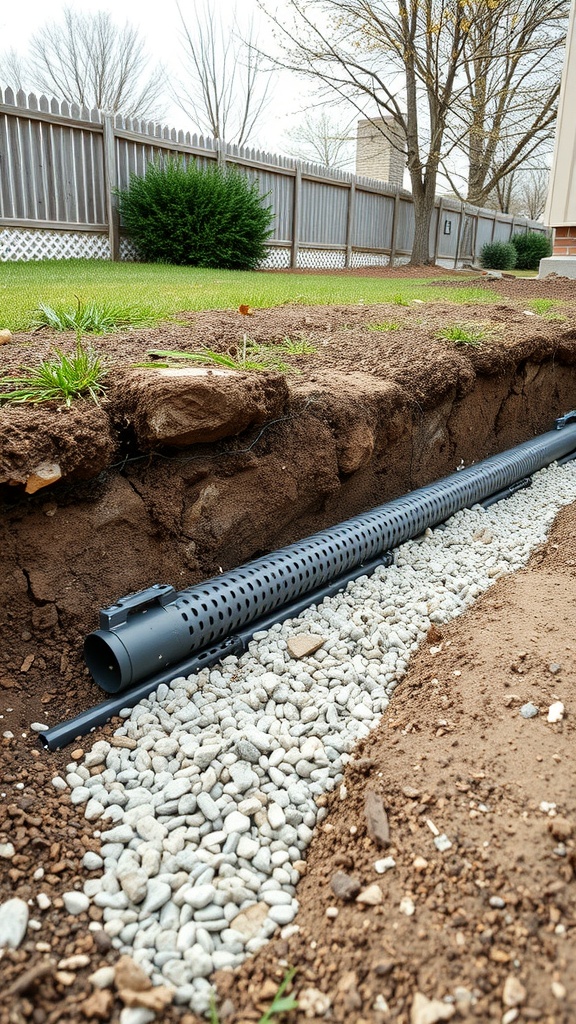
French drains are a smart solution for managing water in your yard. They help direct excess water away from areas where it can cause problems, like your foundation or garden beds. The image shows a trench with a perforated pipe surrounded by gravel, which is the core of a French drain system.
The pipe collects water from the surrounding soil and channels it away, preventing pooling and flooding. This setup is especially useful in areas with heavy rainfall or poor drainage. Installing a French drain can save you from costly water damage and keep your yard looking great.
To create a French drain, you’ll need to dig a trench, lay down the pipe, and cover it with gravel. Make sure the trench slopes away from your home to ensure proper drainage. This simple yet effective method can make a big difference in how your yard handles water.
Permeable Pavers for Driveways
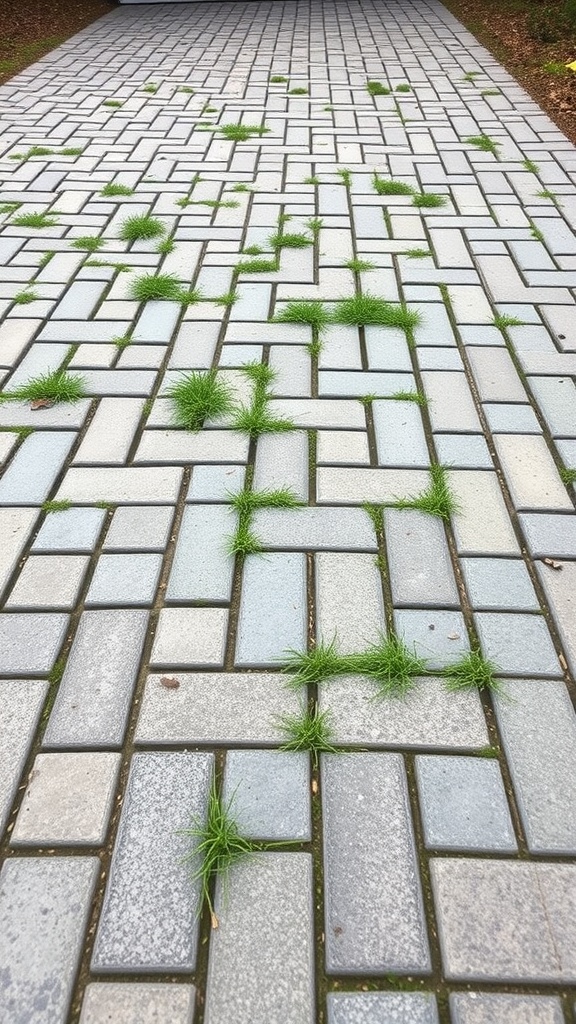
Permeable pavers are a fantastic choice for driveways, especially if you’re looking to manage drainage effectively. The image shows a driveway made of these pavers, with patches of grass growing between them. This design not only looks appealing but also allows water to seep through, reducing runoff and helping with drainage.
Using permeable pavers can help prevent puddles and flooding in your yard. The gaps between the pavers let rainwater filter into the ground, replenishing groundwater and keeping your landscape healthy. Plus, the natural look of grass peeking through adds a touch of greenery, making your driveway blend beautifully with the surroundings.
When considering permeable pavers, think about the layout and materials. There are various styles available, from classic brick to modern concrete designs. Each option can enhance your home’s curb appeal while serving a practical purpose. Installing these pavers can be a DIY project or done by professionals, depending on your comfort level.
Grading Your Yard for Proper Drainage
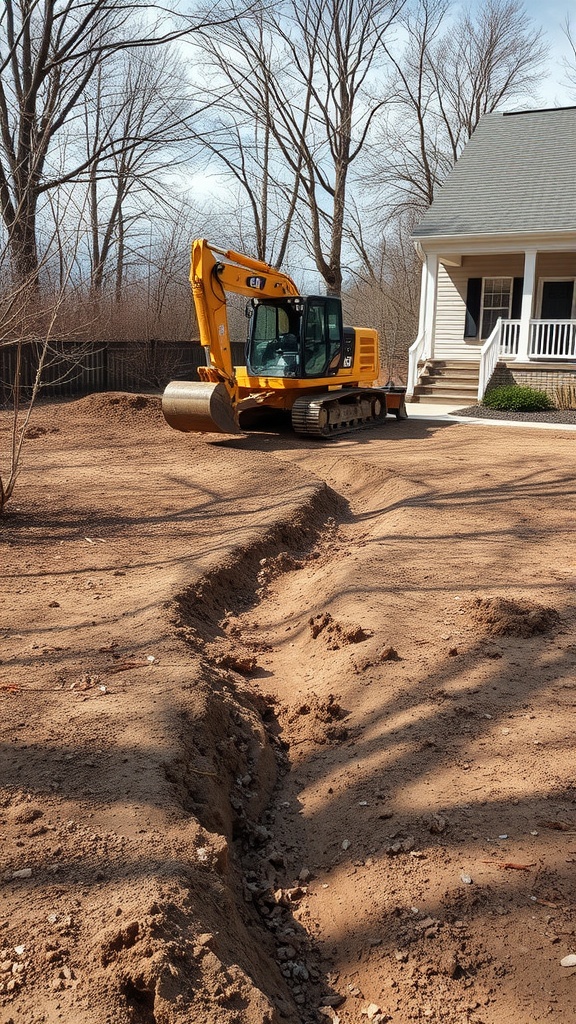
Grading your yard is a key step in managing drainage effectively. The image shows a construction machine parked on a freshly graded area, indicating work in progress. This heavy equipment is essential for reshaping the land to direct water away from your home.
Proper grading involves sloping the ground away from your house. This prevents water from pooling near the foundation, which can lead to serious issues like flooding or structural damage. The visible trench in the image highlights the importance of creating channels for water to flow, ensuring it moves away from critical areas.
When planning your grading project, consider the natural contours of your yard. You want to create a gentle slope, ideally at a 2% grade, which means a drop of about 2 inches for every 10 feet. This will help water drain efficiently without causing erosion.
Using a machine like the one in the image can make this task much easier. It allows for precise adjustments and can handle larger areas quickly. If you’re doing it yourself, a shovel and rake can work, but it will take more time and effort.
Once your yard is graded, you can enhance drainage further with features like French drains or dry wells. These additions can help manage excess water, keeping your yard healthy and your home safe.
Dry Wells for Stormwater Storage
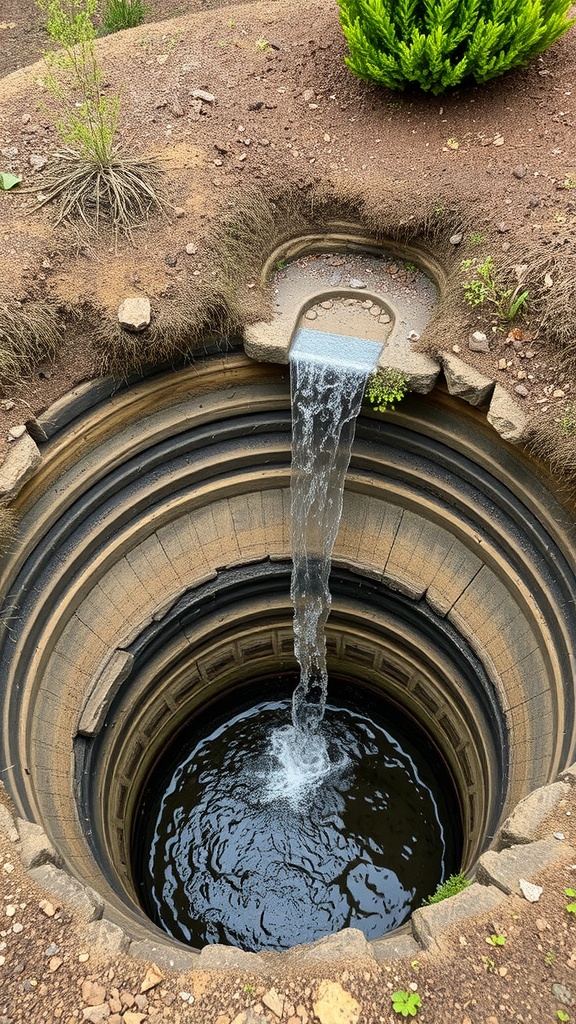
Dry wells are a smart solution for managing stormwater in your yard. They help collect and store excess rainwater, preventing flooding and erosion. The image shows a well designed for this purpose, with water flowing into it. This setup allows the water to slowly seep into the ground, replenishing the soil and reducing runoff.
Incorporating a dry well can be a simple DIY project. You can dig a hole and fill it with gravel, or purchase a pre-made unit. The key is to ensure it’s placed in a location where water naturally collects. This way, it can effectively capture stormwater and keep your yard dry.
Adding plants around the dry well can enhance its function. They help absorb some of the water and add beauty to your landscape. Plus, it’s a great way to make your yard more eco-friendly. With a dry well, you can manage stormwater effectively while keeping your outdoor space looking great.
Swales for Natural Water Flow
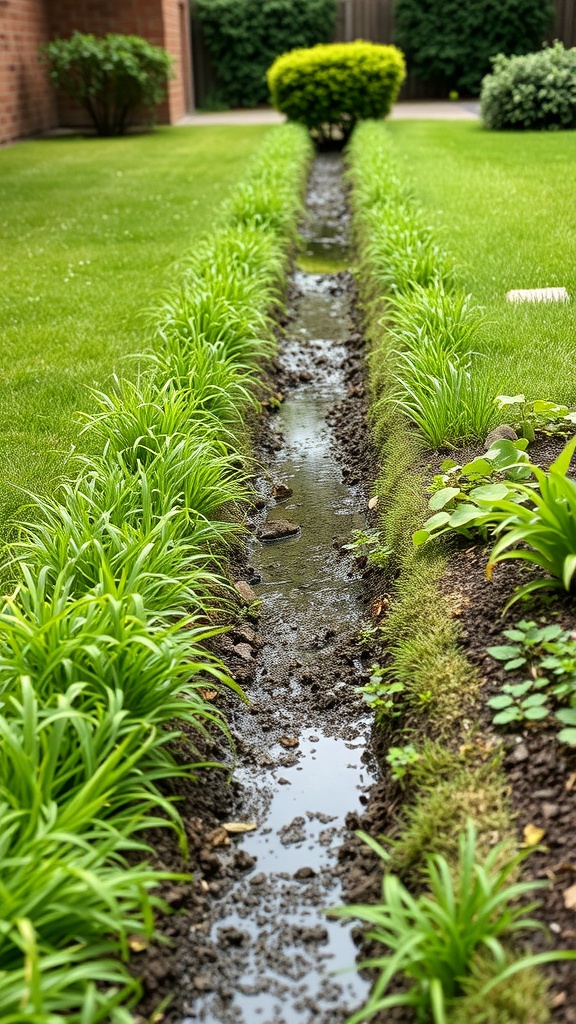
Swales are a fantastic way to manage water flow in your yard. They are shallow, vegetated channels designed to direct water runoff. The image shows a well-maintained swale, lined with lush greenery, guiding water through the landscape.
This natural drainage solution not only helps prevent flooding but also enhances the beauty of your yard. The grass and plants on either side of the swale absorb excess water, reducing erosion and promoting healthy soil.
Creating a swale can be a simple DIY project. Start by identifying areas where water tends to pool. Then, dig a gentle slope to form the swale, ensuring it leads to a designated drainage area. Planting native grasses and flowers along the edges will help stabilize the soil and add visual interest.
Swales are eco-friendly and can be a great addition to any garden. They support local wildlife and improve water quality by filtering pollutants. Plus, they can be designed to fit seamlessly into your landscape, making them both functional and attractive.
Bioswales for Urban Drainage
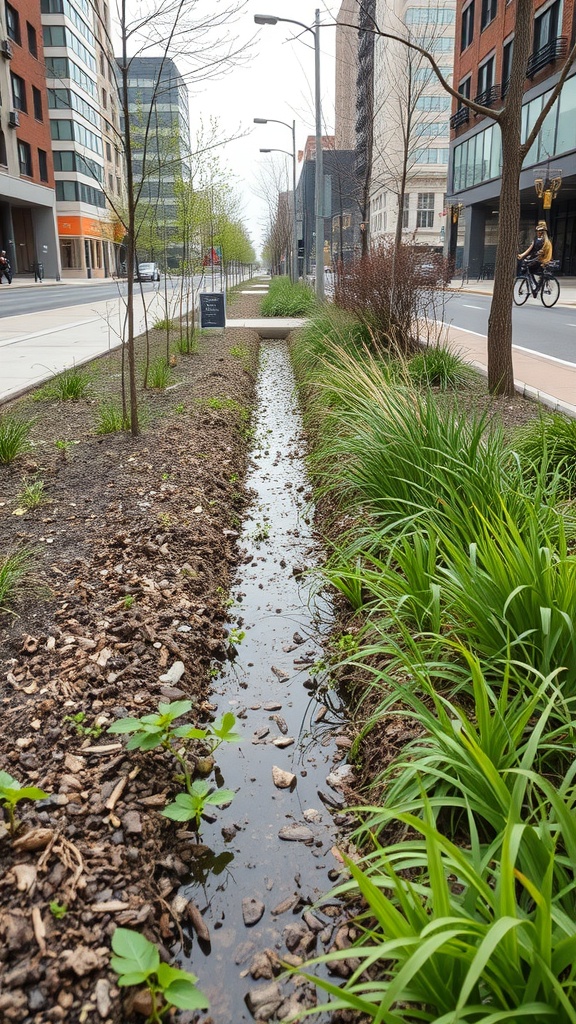
Bioswales are a smart way to manage stormwater in urban areas. They are designed to collect and filter rainwater, helping to reduce flooding and improve water quality. The image shows a well-constructed bioswale, lined with plants and gravel, which channels water effectively.
In the picture, you can see a narrow channel filled with water, surrounded by lush greenery. This setup not only looks good but also serves a vital purpose. The plants help absorb excess water and filter pollutants, making the environment healthier.
Using bioswales in city planning can transform dull streets into green spaces. They provide a natural solution to drainage issues while enhancing the aesthetic appeal of urban areas. Plus, they create habitats for local wildlife, promoting biodiversity.
Implementing bioswales is a win-win for cities. They help manage stormwater effectively and contribute to a greener, more sustainable urban landscape.
Rain Barrels for Water Collection
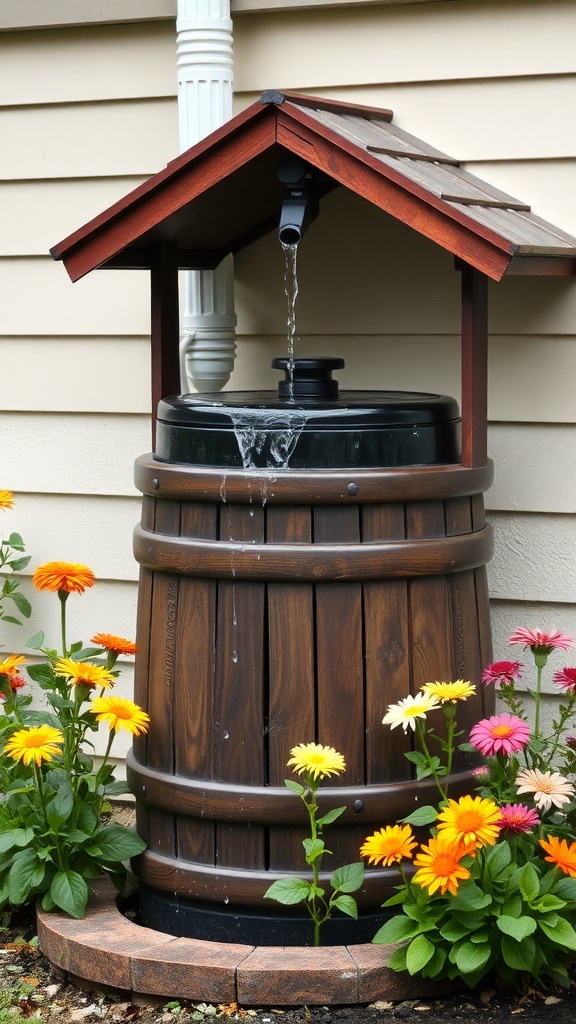
Rain barrels are a fantastic way to collect and store rainwater. This not only helps in conserving water but also reduces runoff in your yard. The image shows a charming rain barrel, complete with a wooden roof and vibrant flowers surrounding it. This setup not only serves a practical purpose but also adds a decorative touch to your garden.
Using a rain barrel is simple. You can connect it to your downspout, allowing rainwater to flow directly into the barrel. This collected water can be used for watering plants, washing your car, or even filling a kiddie pool. It’s a great way to make the most of natural resources.
Incorporating a rain barrel into your yard drainage ideas can be both eco-friendly and cost-effective. Plus, it’s an easy DIY project that can enhance your outdoor space. So, why not consider adding one to your garden?
Soakaways for Groundwater Recharge
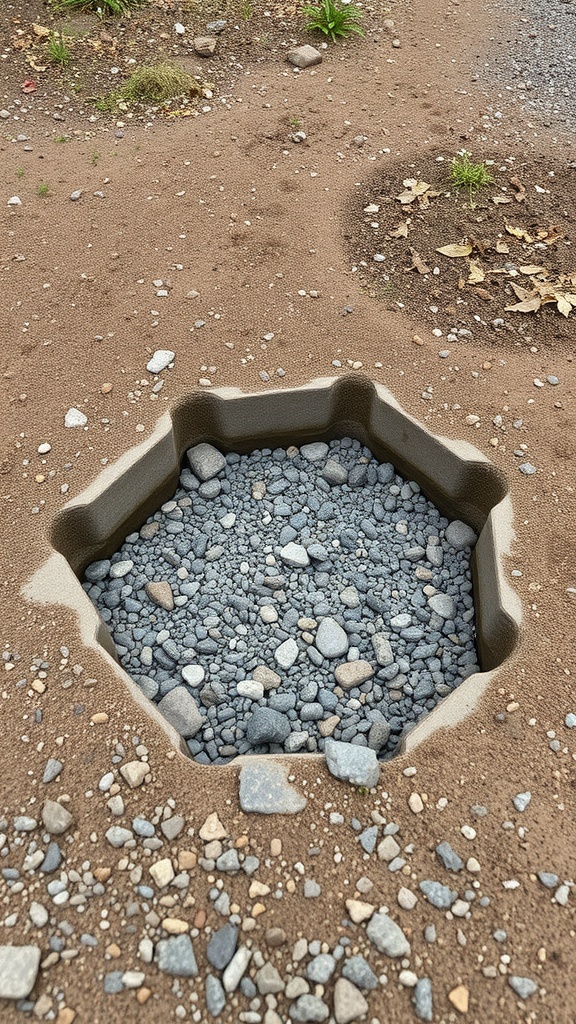
Soakaways are a fantastic solution for managing excess rainwater in your yard. The image shows a well-constructed soakaway, designed to allow water to seep into the ground. This helps recharge groundwater and reduces surface runoff.
The soakaway in the picture features a hexagonal shape, surrounded by gravel. This design not only looks appealing but also enhances drainage efficiency. The gravel allows water to flow through easily, preventing pooling and erosion.
Installing a soakaway can be a simple DIY project. Start by digging a hole and filling it with gravel. Make sure to place it in an area where water tends to accumulate. This will help keep your yard dry and healthy.
Using soakaways is an eco-friendly way to manage water. They promote groundwater recharge, which is essential for maintaining local ecosystems. Plus, they can save you from costly drainage issues in the future.
Rain Gardens to Absorb Excess Water
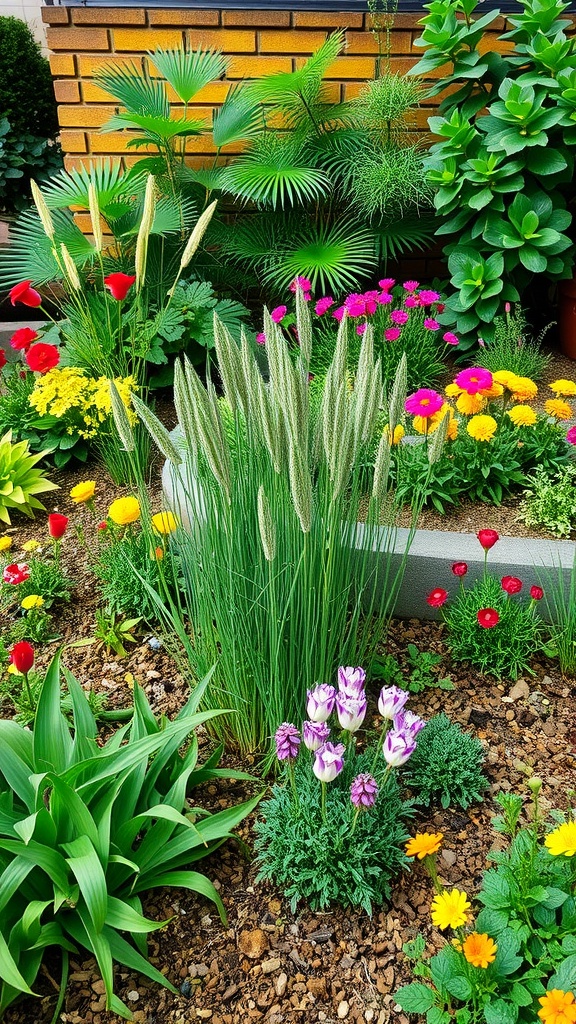
Rain gardens are a fantastic way to manage excess water in your yard while adding beauty to your landscape. The image shows a vibrant garden filled with colorful flowers and lush greenery, making it an inviting spot for both people and wildlife.
These gardens are designed to collect rainwater runoff from roofs, driveways, and sidewalks. The plants in a rain garden help absorb the water, preventing flooding and erosion. In the picture, you can see a mix of flowers and grasses that thrive in wet conditions, showcasing how effective and attractive a rain garden can be.
Creating a rain garden is simple. Start by choosing a location that collects water naturally. Then, select native plants that can handle both wet and dry conditions. The diverse colors and textures in the image highlight how you can create a visually appealing space while solving drainage issues.
Not only do rain gardens help with drainage, but they also support local wildlife. Birds and butterflies are often attracted to these gardens, adding life and movement to your yard. The image captures this idea perfectly, with its lush plants and vibrant blooms.
Sump Pumps for Basement Protection
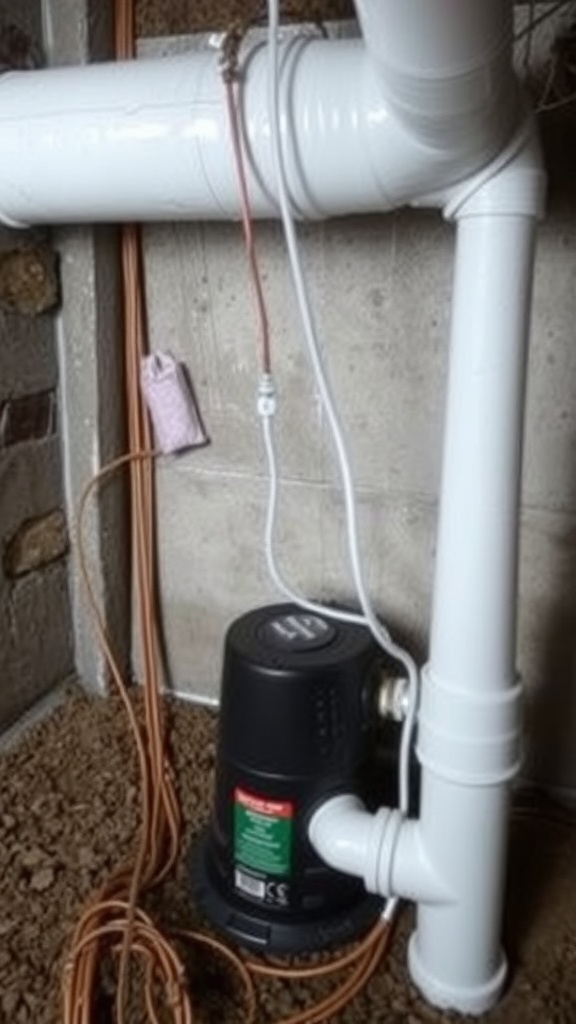
Sump pumps are a key part of keeping your basement dry and safe. They work by removing excess water that can accumulate, especially during heavy rains or snowmelt. The image shows a sump pump setup, featuring a pump unit and drainage pipes. This setup is essential for preventing water damage in your home.
When water collects in a sump pit, the pump activates and sends the water away from your foundation. This helps to avoid flooding and keeps your basement free from mold and mildew. Installing a sump pump can be a smart investment for any homeowner.
Regular maintenance is important too. Make sure to check the pump periodically to ensure it’s working properly. This includes cleaning the sump pit and testing the pump to see if it activates as it should. A little upkeep can go a long way in protecting your home.
Catch Basins for Surface Water
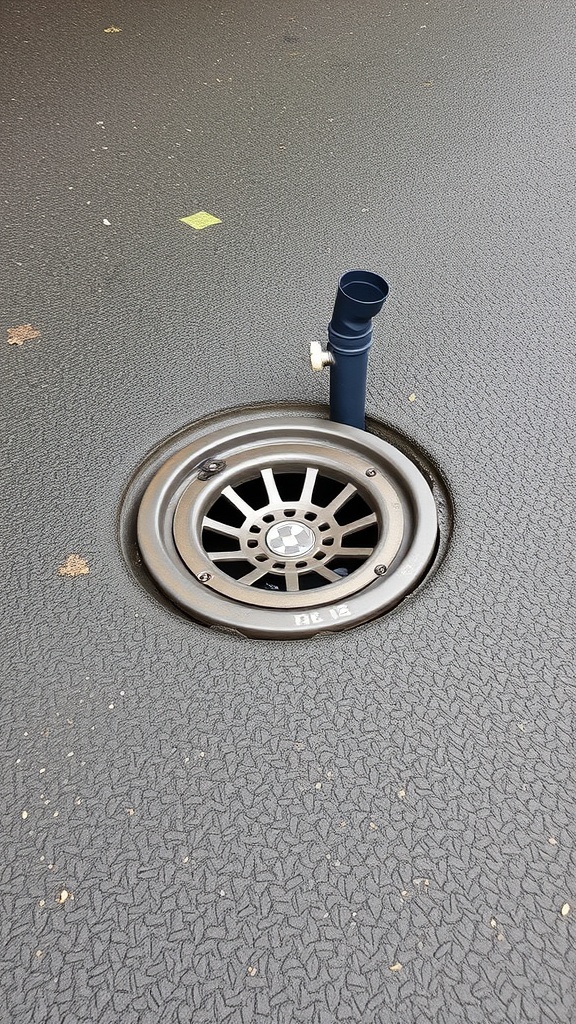
Catch basins are a smart solution for managing surface water in your yard. They help collect rainwater and prevent pooling, which can damage your landscape and foundation. The image shows a catch basin with a stylish cover, blending functionality with aesthetics.
This particular catch basin features a unique design, resembling a wheel rim, which adds a bit of flair to the drainage system. The attached pipe directs water away from the basin, ensuring efficient drainage. This setup is perfect for areas prone to heavy rainfall.
Installing a catch basin can be a straightforward DIY project. Just make sure to place it in low spots where water tends to gather. This way, you can keep your yard dry and maintain its beauty.
Vegetative Filter Strips for Runoff Control
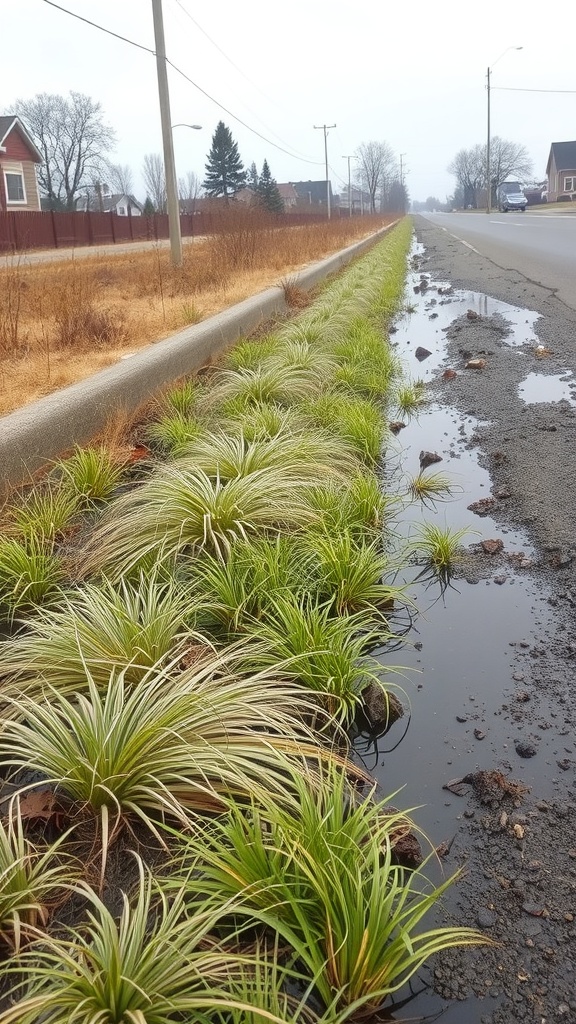
Vegetative filter strips are a smart way to manage runoff in your yard. These strips consist of grasses and plants that help filter water before it reaches storm drains or nearby water bodies. The image shows a well-maintained vegetative strip along a road, showcasing how plants can thrive while also serving a practical purpose.
The lush greenery in the picture is not just for looks. The plants absorb water, reducing the amount of runoff that can cause erosion or pollution. They act like a sponge, soaking up excess water and allowing it to slowly seep into the ground. This process helps recharge groundwater and keeps nearby water sources cleaner.
Installing a vegetative filter strip is a simple yet effective way to enhance your yard’s drainage system. Choose native plants that are well-suited to your local climate. They require less maintenance and are more resilient to pests. Plus, they add beauty to your landscape!
Incorporating these strips can also improve biodiversity in your area. Birds and beneficial insects are attracted to the plants, creating a healthier ecosystem. So, not only do you get better drainage, but you also support local wildlife.
Trench Drains for Pathways
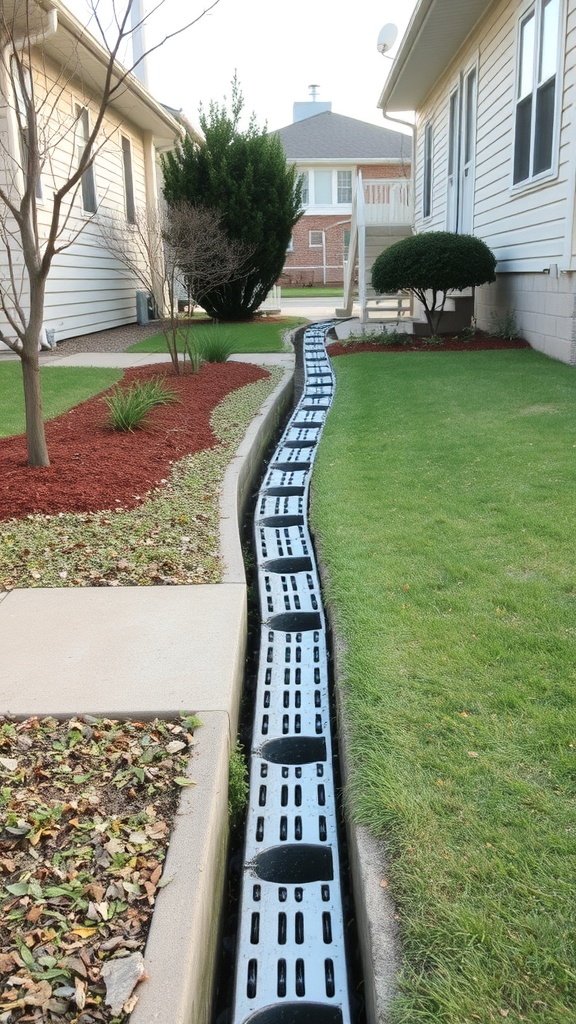
Trench drains are a smart choice for managing water flow around your pathways. They help keep your walkways dry and safe, especially during heavy rain. The image shows a well-installed trench drain running alongside a pathway, effectively channeling water away from the area.
These drains are designed to blend in with your landscape. In the picture, you can see how the drain fits neatly between the grass and the pathway. This design not only serves a functional purpose but also maintains the aesthetic appeal of your yard.
Installing a trench drain can prevent water pooling, which can lead to slippery surfaces and potential accidents. It’s a simple solution that can save you from bigger problems down the line. Plus, they come in various styles and materials, allowing you to choose one that matches your outdoor decor.
Overall, trench drains are a practical addition to any yard. They keep pathways clear and dry, making your outdoor space more enjoyable. If you’re looking for an effective drainage solution, consider adding a trench drain to your pathways.
Landscape Grates for Aesthetic Drainage Solutions
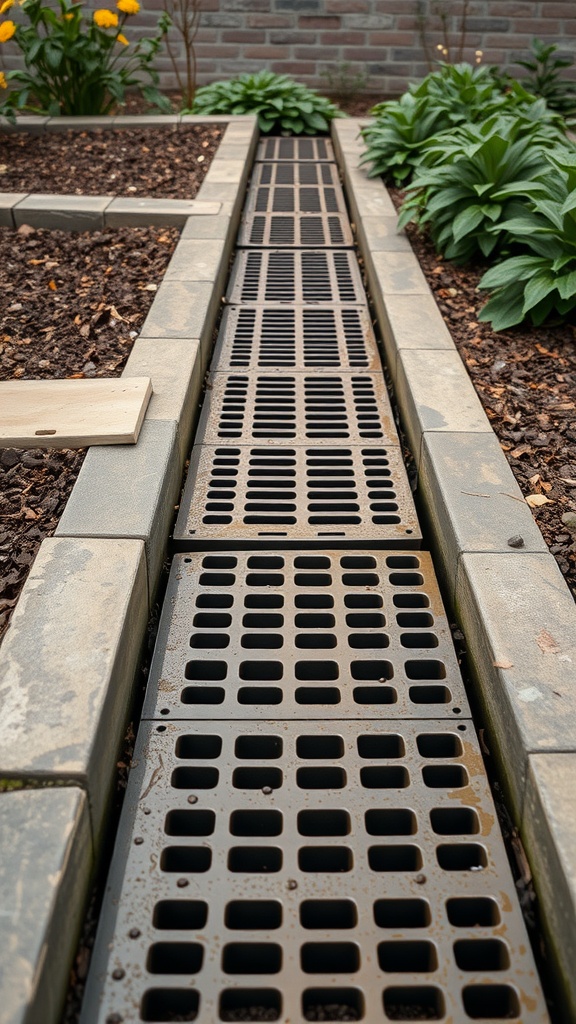
When thinking about yard drainage, aesthetics often take a backseat. However, landscape grates can change that. The image shows a neat drainage system with grates that blend well with the surrounding plants and soil.
These grates serve a practical purpose while enhancing the overall look of your garden. They help direct water away from areas prone to pooling, keeping your yard dry and healthy. The design is functional yet stylish, making it a great choice for homeowners who care about both form and function.
Incorporating landscape grates can also highlight your garden’s features. The clean lines and modern materials can complement flowers and shrubs, creating a cohesive look. Plus, they’re easy to maintain, ensuring your yard stays beautiful without much effort.
So, if you’re looking for drainage solutions that don’t compromise on style, consider these landscape grates. They provide a smart way to manage water while keeping your outdoor space inviting.

